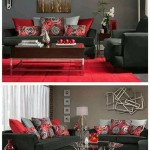How to Decorate a Bedroom Sitting Area
Transforming a bedroom into a sanctuary involves more than just a comfortable bed; it often includes incorporating a dedicated sitting area. This space offers a refuge for relaxation, reading, working, or simply enjoying a moment of peace. However, creating a cohesive and inviting sitting area requires thoughtful planning and execution. This guide offers practical steps and considerations for effectively decorating this valuable addition to a bedroom.
The primary goal when decorating a bedroom sitting area should be to create a space that feels both functional and aesthetically pleasing. Consider how the area will be primarily used and design accordingly, ensuring the arrangement complements the existing bedroom decor. The size and layout of the bedroom will dictate the potential size and configuration of the sitting area. A small bedroom may only accommodate a single armchair, while a larger space might allow for a loveseat, coffee table, and even a small desk. Careful planning is crucial to avoid overcrowding and maintain a sense of spaciousness.
Selecting the Right Furniture
The furniture choices form the foundation of the sitting area's design. The selection process must consider both style and comfort. Prioritize options that align with the overall aesthetic of the bedroom. For example, a modern bedroom sitting area might benefit from clean lines and minimalist furniture, while a Bohemian style would likely embrace plush fabrics, patterned cushions, and natural wood elements.
Key furniture elements often include a comfortable seating option, such as an armchair, loveseat, or even a chaise lounge. The size and scale of the seating should be proportional to the room’s dimensions. A small side table or coffee table provides a surface for placing drinks, books, or decorative items. Consider incorporating an ottoman for comfortable footrest or additional seating when needed. A reading lamp or floor lamp is essential for proper lighting, allowing users to create a cozy atmosphere for activities such as reading.
Choosing Complementary Colors and Textures
Color and texture contribute significantly to the ambiance of a sitting area. The color palette should harmonize with the existing bedroom decor, helping to create a seamless and unified aesthetic. Neutral colors, such as whites, grays, and creams, offer a versatile base that allows for pops of color through accent pieces such as throw pillows, artwork, or rugs. Alternatively, a bold color scheme can be incorporated to create a focal point within the bedroom.
Textural elements, such as soft throws, plush rugs, and varied fabrics, introduce depth and visual interest. Consider incorporating textures that contrast with the furniture's materials. For example, a leather armchair can be complemented by a woven throw blanket or a velvet cushion. The careful use of different textures can enhance the overall comfort and sensory experience of the sitting area, making it an inviting space for relaxation.
Optimizing Lighting and Ambiance
Lighting plays a crucial role in setting the mood and functionality of the sitting area. The lighting scheme should provide a combination of ambient, task, and accent lighting. Ambient lighting, such as a ceiling fixture or recessed lighting, provides general illumination. Task lighting, like a reading lamp, is essential for activities requiring focused light. Accent lighting, which may include table lamps or decorative string lights, can be used to highlight specific features and create a cozy atmosphere.
The placement of lighting fixtures should be strategic. Ensure that task lighting is positioned appropriately for reading or working. Adjustable lamps offer flexibility and control over the light's direction and intensity. Dimmer switches allow for adjusting the brightness and setting the appropriate mood. Consider the use of natural light and the placement of windows when making lighting decisions. Sheer curtains or blinds can be used to filter sunlight and maintain privacy while allowing natural light to stream into the space.
Incorporating Personal Touches and Accessories
Personalizing the sitting area with accessories and decorative items adds character and reflects the occupant’s individual style. Artwork, photographs, and decorative objects can be used to express personal interests and preferences. Consider displaying artwork that complements the color scheme and style of the room. Family photographs can create a comforting and familiar atmosphere. Decorative objects, such as vases, sculptures, or bowls, can add visual interest and personality.
Throws and cushions are excellent accessories for adding comfort and visual appeal. Choose throw pillows that feature contrasting colors, patterns, or textures to create a layered effect. A soft throw blanket can provide warmth and a cozy look, while also adding a textural element. Rugs can define the sitting area and further enhance comfort, adding a sense of warmth to the space. The rug choice should consider the size of the sitting area and the overall bedroom design aesthetic.
Arrangement and Flow
The arrangement of furniture and accessories is critical for creating a functional and visually appealing sitting area. The furniture layout should facilitate easy movement and access to the various elements within the space. Consider traffic flow and ensure that there is ample space to navigate around the sitting area. Experiment with different furniture arrangements to find the layout that best maximizes space and functionality.
Ensure the sitting area is positioned to maximize the use of natural light and offer a pleasant view, if possible. Consider the placement of windows and doors when planning the arrangement. A well-arranged sitting area should feel balanced and harmonious, with each element contributing to the overall aesthetic and functionality of the space. Avoid overcrowding and create a sense of open space and visual balance. The correct room arrangement can create open space and avoid tight pathways that make the area less enjoyable.
Maintaining Functionality and Clutter Management
Maintaining a clutter-free sitting area is crucial for preserving its relaxing and functional qualities. Implement storage solutions to keep the space organized and prevent clutter from accumulating. Consider incorporating storage ottomans, side tables with drawers, or decorative baskets to store books, magazines, or other items. Regularly declutter the space to remove unnecessary objects and maintain a clean and inviting atmosphere.
Establish routines to keep items organized and to control the number of things in the sitting area. Designate specific spots for items used in the sitting area, such as a tray for holding remotes or a basket for books. Regularly dust and vacuum the furniture and surfaces to keep them clean and well-maintained. The careful management of clutter and the focus on cleanliness are essential for maintaining the sitting area as a relaxing and enjoyable space.
:strip_icc()/ReagenTaylorPhotography-d6d99295d6c84b468d8c12dfc0a0386b.jpg?strip=all)
10 Beautiful Bedroom Sitting Area Ideas

Main Bedroom Sitting Area Ideas

10 Best Bedroom Sitting Area Ideas For Private Relaxation Decorilla

Main Bedroom Sitting Area Ideas

Coordinating The Master Bedroom Sitting Area To Kelley Nan

Main Bedroom Sitting Area Ideas
:strip_icc()/ErinWilliamson1-910e332477dd4d2f910aff2af704bc3c.jpg?strip=all)
10 Beautiful Bedroom Sitting Area Ideas

10 Best Bedroom Sitting Area Ideas For Private Relaxation Decorilla

Ideas For Your Master Bedroom With Sitting Area Kerley Family Homes

Master Bedroom Sitting Area Design Ideas
Related Posts







